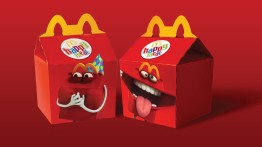COOPERMADE: Happy Meals

In 2000, Cooper Union art alumnus Simms Taback A'53 (1932-2011) was awarded the Caldecott Medal, the most prestigious prize given for a picture book for his Joseph Had a Little Overcoat (1999). The book, an adaptation of a Yiddish folktale, uses collage to tell the story in colorful spreads, a stellar example of the expressionistic approach to storytelling adopted by his generation of picture book illustrators. Though most celebrated for his many children’s books, Taback, a Bronx native whose first language was Yiddish, had already established a successful career in graphic design, working for Columbia Records and The New York Times, and as an advertising artist for Eastern Airlines and American Express, among others. Later, he teamed with his fellow Cooper alumnus, Push Pin Studios co-founder Reynold Ruffins A’51, to launch a greeting card company, Cardtricks. Taback was also known as an indefatigable champion of working artists, serving as president of the Graphic Artists Guild where he fought for artists’ copyrights. In short, through his art and activism, he communicated to tens of thousands of people.
Yet if it’s a matter of numbers alone, Taback almost certainly reached his biggest audience through a single package design he undertook in 1976: the box for the newly launched McDonald’s Happy Meal. The concept of the Happy Meal began in Guatemala where Yolanda Fernández de Cofiño, whose husband owned all the country’s McDonald’s franchises, began to offer what she called the “Menu Ronald,” a pre-packaged meal for children. On learning of de Cofiño’s success, McDonald’s central offices hired the marketing firm of Bernstein-Rein to develop a similar idea for the American market. The firm’s CEO, Bob Bernstein, studied his own son’s breakfast table behavior and realized that a box with stories and activities—much like kids’ cereal boxes—would lead to requests for the meals from the half-pint diners themselves. At that point Taback, well known for his whimsical children’s illustrations, was tapped to design the first Happy Meal boxes. He divided the box into different frames; in each one, he illustrated an act—a drawing challenge, a quiz, and a riddle. Today, the original sketches he made for that first Happy Meal box are in the collection of the Smithsonian Institution.





